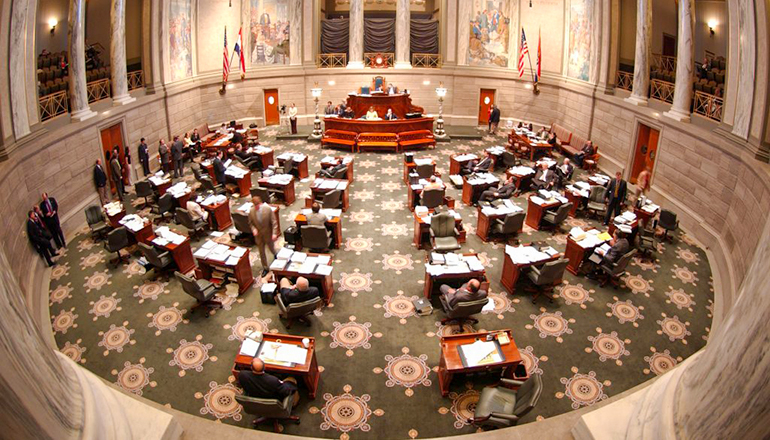(Missouri Independent) – The Missouri Senate passed a congressional redistricting map Thursday and then adjourned for the year.
The 22-11 vote came after Senate Majority Leader Caleb Rowden invoked a rarely-used rule to bring a bill from the Senate Select Committee on Redistricting to the floor.
The adjournment came a day before the constitutionally mandated end of the session. It was the first time the rule to bring a bill out of committee was used since 1979. And it was one of the few times either chamber of the General Assembly has quit working a day early since a fixed adjournment date was added to the constitution in 1952.
All the opposition votes came from members of the chamber’s conservative caucus, who have spent the entire session calling for a map that would give the GOP another seat in the state’s delegation.

The motion bringing the bill out of committee was signed by 12 senators and caught members of the conservative caucus off guard, leading Sen. Bob Onder, R-Lake St. Louis, to accuse the leadership of a “sneak attack.”
The bill, which was passed Monday in the Missouri House, now goes to Gov. Mike Parson. If Parson signs the bill, it will take effect immediately and be used for the Aug. 2 primaries.
Onder tried to put off debate by arguing that the rules required a day’s delay. When that was overruled, he challenged the result. The Senate voted 26-5 to move ahead with the bill.
Missouri is entitled to eight seats in the U.S. House of Representatives, and districts must be revised every 10 years after a national census. The first plan, released in December with backing from the Republican leaders of both chambers, essentially kept the partisan breakdown of the state’s delegation unchanged, with six safe Republican districts and two Democratic districts in Kansas City and St. Louis.
The House passed that bill in January and, after weeks of on-and-off debate, the Senate passed a significantly altered version in late March.
The seven members of the Senate’s conservative caucus demanded a map that cracked the Kansas City district and combined it with a huge swath of rural counties to make it possible for the GOP to capture the seat.
The “6-2” vs. “7-1” debate came to a head in February when the conservative caucus began a filibuster that blocked progress not only on the redistricting plan but also on basically every other bill. At one point, two Republican Senators got into a shouting match and had to be physically separated.
“I don’t think that 7-1 was even remotely possible,” Rowden said Wednesday on the floor. “Even for the folks who were advocating for it originally.
Since the Senate vote, the House has been unwilling to vote on the Senate version and the upper chamber has refused to negotiate. To break the impasse, the House passed a new bill Monday. It was initially set for a Senate committee hearing Wednesday, but with the floor tied up with debate on other bills, the meeting was pushed to Thursday.
When the time came for the hearing, Chairman Mike Bernskoetter, R-Jefferson City, gaveled the panel into session and immediately called a recess. Five hours later, the bill was on the floor.
“I believe the new map does a good job of balancing Missouri’s regions and their different views,” Bernskoetter said. “It meets all the requirements we are constitutionally obligated to meet.”
Throughout the day, rumors that the Senate leadership would shut off debate hung over the chamber. It did not happen because conservative caucus members decided to have their say and sit down.
“The process stinks to high heaven,” Onder said as the bill came to a vote. “For what reason did leadership use a discharge petition to get this to the floor? Was that some kind of sick power play?”
Sen. Bill Eigel, R-Weldon Spring, also said he didn’t like the final map. Like Onder, he’s from St. Charles County, which both had hoped to keep whole in the new arrangement.
“I am disappointed it looks like we are going to take a larger split in our county,” Eigel said.
The map balanced the interests of all sections of the state, Bernskoetter said and has as few county splits as possible. The ideas for a 7-1 map would have drawn Kansas City voters into districts with large numbers of rural voters, he noted.
“It just never made any sense to me,” Bernskoetter said, “to bust up those communities of interest.”


